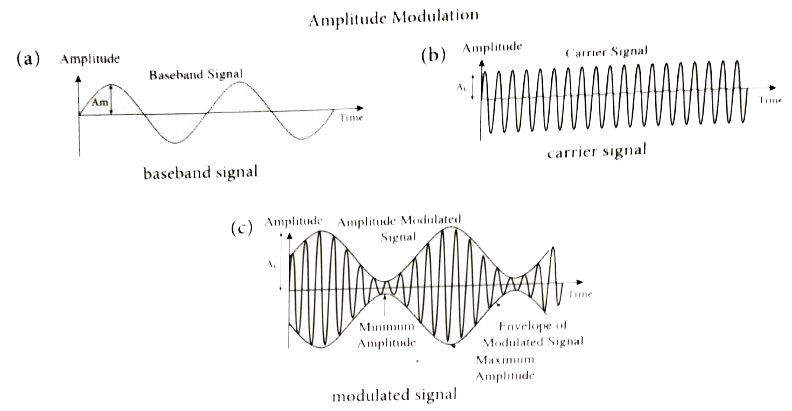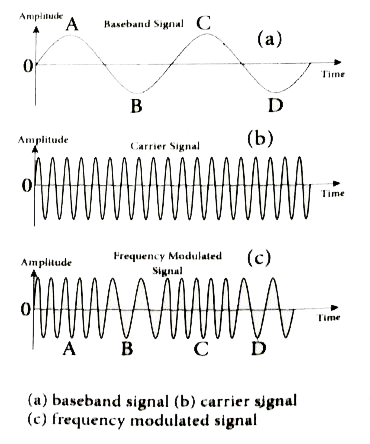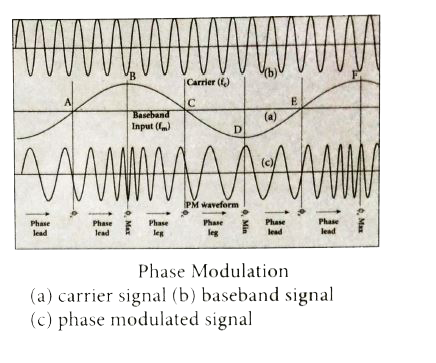What is modulation? Explain the types of modulation with necessary diagrams.Solution in Tamil
Modulation: For long distance transmission, the low frequency baseband signal (input signal) is superimposed onto a high frequency radio signal by a process called modulation. There are 3 types of modulation based on which parameter is modified. They are (i) Amplitude modulation (ii) Frequency modulation, and (iii) Phase modulation.
(i) Amplitude Modulation (AM): If The amplitude of the carrier signal is modified according to the instantaneous amplitude of the baseband signal, then it is called amplitude modulation. Here the frequency and the phase of the carrier signal remain constant Amplitude modulation is used in radio and TV broadcasting.

The signal shown in figure() is the message signal or baseband signal that carries information figure (b) shows the high frequency carrier signal and figure (e) gives the amplitude modulated signal. We can see clearly that the carrier wave is modified in proportion to the amplitude of the baseband signal.
(ii) Frequency Modulation (FM):The frequency of the carrier signal is modified according to the instantaneous amplitude of the baseband signal in frequency modulation. Here the amplitude and the phase of the carrier signal remain constant. Increase in the amplitude of the baseband signal increases the frequency of the carrier signal and vice versa. This leads to compressions and rarefactions in the frequency spectrum of the modulated wave. Louder signal leads to compressions and relatively weaker signals to rarefactions When the amplitude of the baseband signal is zero in Figure (a), the frequency of the modulated signal is the same as the carrier signal. The frequency of the modulated wave increases when the amplitude of the baseband signal increases in the positive direction (A, C). The increase in amplitude in the negative half cycle (B, D) reduces the frequency of the modulated wave (Figure (c)).

(iii) Phase Modulation (PM): The instantaneous amplitude of the baseband signal modifies the phase of the carrier signal keeping the amplitude and frequency constant is called phase modulation. This modulation is used to generate frequency modulated signals. It is similar to frequency modulation except that the phase of the carrier is varied instead of varying frequency. The carrier phase changes according to modulating signal goes positive, the amount of phase lead increases with the amplitude of the modulating signal. Due to this, the carrier signal is compressed or its frequency is increased. On the other hand, the negative half cycle of the baseband signal produces a phase lag in the carrier signal. This appears to have stretched the frequency of the carrier wave. Hence similar to frequency modulated wave, phase modulated wave also comprises of compressions and rarefactions. When the signal voltage is zero (A, C and E) the carrier frequency is unchanged.

Topper's Solved these Questions
- SAMPLE PAPER-1 (SOLVED)Book:FULL MARKSChapter:SAMPLE PAPER-1 (SOLVED)Exercise:Questions
Explore 28 Videos
- SAMPLE PAPER-07 (SOLVED )Book:FULL MARKSChapter:SAMPLE PAPER-07 (SOLVED )Exercise:(PART - IV)(Answer all the questions.)
Explore 10 Videos
- SAMPLE PAPER-16 (UNSOLVED)Book:FULL MARKSChapter:SAMPLE PAPER-16 (UNSOLVED)Exercise:PART-IV
Explore 10 Videos
Similar Questions
What is meant by Fraunhofer lines?
View SolutionCalculate the electric field due to a dipole on its equatorial plane. (OR) Electric field due to an electric dipole at a point on the equatorial plane
View SolutionDerive an expression for electrostatic potential energy of the dipole in a uniform electric field .
View Solutionमॉडुलन समझाए और इसके प्रकार बताएँ।
View Solutionसंचार तंत्र में मॉडुलन एवं विमॉडुलन क्या है ? मॉडुलन की आवश्यकता समझाइए तथा मॉडुलन के प्रकार लिखिए।
View SolutionWhat is modulation necessary ?
View Solutionमॉडुलन कितने प्रकार का होता है ? प्रत्येक प्रकार को समझाइए ।
View Solutionआयाम मॉडूलन क्या है ? आयाम मॉडूलन सूचकांक आयाम मॉडूलित तरंग का निर्माण करने के विधि का आवश्यक परिपथ आरेख सहित वर्णन कीजिए।
View SolutionWhat is modulation? Explain the types of modulation
View SolutionWhat is modulation? Explain the types of modulation with necessary diagrams.
View SolutionWhat is modulation? Explain the types of modulation with necessary diagrams.
View SolutionWhat is modulation? Explain the types of modulation with necessary diagrams.
View Solutionमॉडुलन क्यों आवश्यक है? समझाइये।
View SolutionWhat is modulation ? Explain different types of modulation.
View SolutionIn the broadcast of communication modulation is necessary:-What do you mean by modulation?
View Solution

